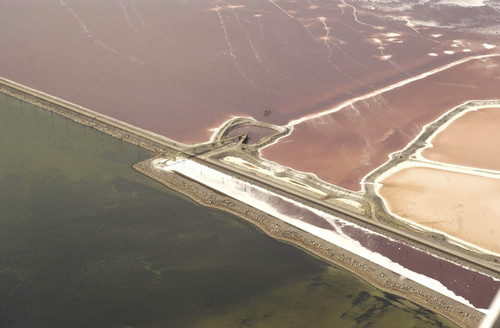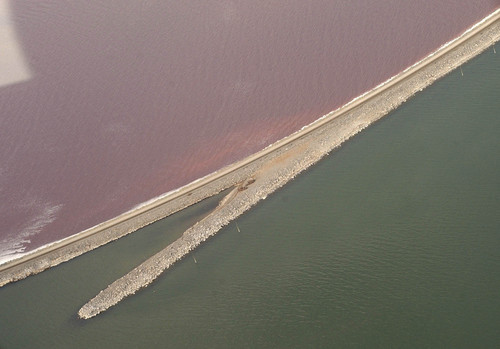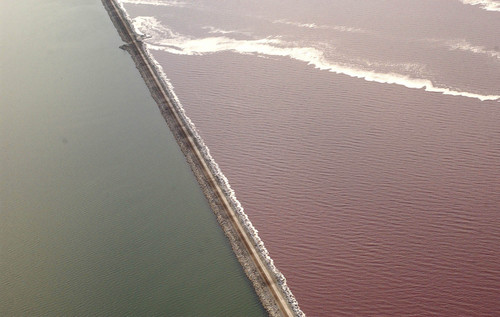This is an archived article that was published on sltrib.com in 2013, and information in the article may be outdated. It is provided only for personal research purposes and may not be reprinted.
The one remaining culvert on the Union Pacific causeway across the Great Salt Lake is in "imminent" peril of collapse, putting vital freight traffic at risk of derailing unless the culvert is filled immediately, according to documents the company submitted to the U.S. Army Corps of Engineers last month.
The railroad is seeking emergency permission to retire the culvert, now the only spot on the causeway that allows water to move between the super-saline North Arm and the rest of the lake. After years of sinking into the soft lake bed, the culvert is beyond repair, according to Union Pacific.
Union Pacific wants to replace the culvert with a proposed 180-foot bridge that has yet to be designed.
Federal regulators are hesitant to approve the emergency request without some assurances the bridge will work, but the necessary analysis has yet to be completed.
"We have to ensure that the design at a bare minimum would replicate the functions of the two culverts, the same amount of flow and [that] the flow goes in both directions," said Jason Gipson, the Army Corps' Utah regulatory officer.
The situation, more than 50 years in the making, puts transport safety on a collision course with the ecological health of the lake, which supports crucial resting and nesting spots for migratory birds and $1.3 billion in economic activity.
And Union Pacific has itself to blame, claim lake advocates, who say the railroad has known about the deterioration of its two culverts for years.
"It seems everybody has to jump when there is an immediate threat, but the railroad has spent its fine time dragging its feet coming up with effective mitigation measures," said Lynn de Frietas, executive director of the Friends of the Great Salt Lake.
Union Pacific says it is working to get its bridge proposal approved as soon as possible.
"We are talking to all the state agencies to find out exactly what we need to do to close the culvert," spokesman Aaron Hunt said. "We are inspecting the culvert every day to assure that it won't fail in an effort to avoid a derailment on the causeway."
Up to 15 freight trains a day cross the 21-mile causeway, which shortens the rail route between Ogden and the West Coast.
Before the Army Corps can greenlight the culvert closure, the Clean Water Act requires Union Pacific to gain state certification that the bridge project won't hurt water quality.
The railroad has yet to submit an application. When it does, the Utah Division of Water Quality will likely approve it quickly, but with conditions, according to agency director Walt Baker. That means the railroad must agree to model the mixing effects of the bridge and monitor what actually happens after it is built.
It must also submit plans for mitigating ecological damage should the bridge not perform up to expectations. Baker said the approval process allows for public participation.
The Army Corps allowed the railroad to plug the failing west culvert last year after accepting assurances that the closure would pose minimal risk to lake ecology. But environmentalists contend closing the last culvert poses serious threat to the lake since it would eliminate what little mixing is left.
Meanwhile, the proposed bridge's effectiveness has not been tested.
"Various agencies have submitted extensive comments confirming that unless the bridge is properly designed and located, its construction could well exacerbate the negative effects the causeway has on the Lake ecosystem," the Friends' lawyers, Rob Dubuc and Joro Walker, wrote Friday in a letter to the Corps.
"Of particular concern is that neither the project proponent nor the Army Corps knows at this point what the impacts of the project will be," the letter said.
The railroad completed the causeway in the late 1950s, isolating the North Arm, a massive bay formed by the west shore and Promontory Point. With little freshwater inflow, the arm's water is saturated with salt. The two culverts allowed some water exchange, but these structures have been maintenance headaches from the beginning because of debris clogs and the lake bed's instability.
The main body of the lake is replenished with freshwater from the Jordan and Weber rivers, and mixing with the North Arm helps keep saline levels in balance.
"We are interested in maintaining the equilibrium we have now. We are asking the railroad to replicate that in the construction of their infrastructure," Baker said.
Changes in salinity "could have a cascading effect on brine shrimp and extractive industries," such as potash and magnesium, which rely on evaporative ponds on the lake. Shrimp support not only a commercial egg harvest, but also much of the lake's food chain.







